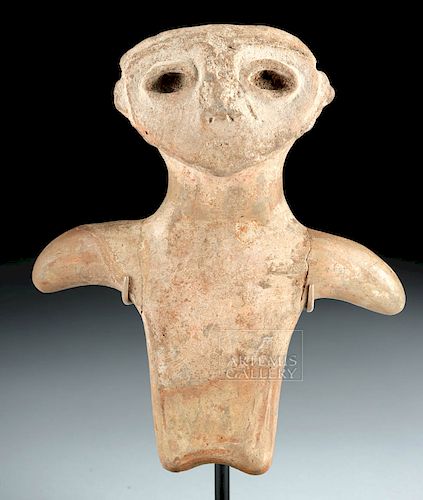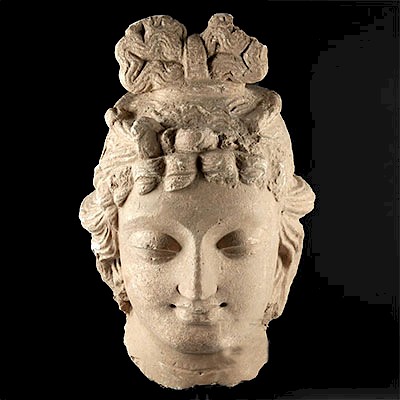Sumerian Ceramic Idol Figure w/ TL
Lot 85a
About Seller
Artemis Gallery
686 S Taylor Ave, Ste 106
Louisville, CO 80027
United States
Selling antiquities, ancient and ethnographic art online since 1993, Artemis Gallery specializes in Classical Antiquities (Egyptian, Greek, Roman, Near Eastern), Asian, Pre-Columbian, African / Tribal / Oceanographic art. Our extensive inventory includes pottery, stone, metal, wood, glass and textil...Read more
Estimate:
$3,500 - $5,500
Absentee vs Live bid
Two ways to bid:
- Leave a max absentee bid and the platform will bid on your behalf up to your maximum bid during the live auction.
- Bid live during the auction and your bids will be submitted real-time to the auctioneer.
Bid Increments
| Price | Bid Increment |
|---|---|
| $0 | $25 |
| $300 | $50 |
| $1,000 | $100 |
| $2,000 | $250 |
| $5,000 | $500 |
| $10,000 | $1,000 |
| $20,000 | $2,500 |
| $50,000 | $5,000 |
| $100,000 | $10,000 |
| $200,000 | $20,000 |
About Auction
By Artemis Gallery
Aug 30, 2018
Set Reminder
2018-08-30 10:00:00
2018-08-30 10:00:00
America/New_York
Bidsquare
Bidsquare : Fine Antiquities / Asian / Ethnographic Art
https://www.bidsquare.com/auctions/artemis-gallery/fine-antiquities-asian-ethnographic-art-3402
Featuring classical antiquities, Asian, ancient and ethnographic art from cultures encompassing the globe, plus fine art. Artemis Gallery info@artemisgallery.com
Featuring classical antiquities, Asian, ancient and ethnographic art from cultures encompassing the globe, plus fine art. Artemis Gallery info@artemisgallery.com
- Lot Description
Ancient Near East, Sumeria, ca. early 2nd millennium BCE. A striking ceramic idol, abstractly anthropomorphic in form. The figure's body is rectangular, with a gentle indent at its base forming legs/feet. Long, downwardly-curving arms extend outward from the upper part of the body. A large, symmetrical head with a sharply pointed chin sits atop the figure's broad neck. The most notable features of the head are the deepset eyes, which likely once contained inlays of some kind - shell or stone, perhaps. Researchers believe that wide open eyes were a sign of attentiveness to the gods. An incised line forms a heavy brow. The back of the head extends outward, mirroring the shape of the face. Size: 4.5" W x 5.25" H (11.4 cm x 13.3 cm); 6.3" H (16 cm) on included custom stand.
Ancient idols like this one, that reduce the human figure to a simple collection of shapes and lines, are considered some of our oldest abstract art. They fascinate us today in part because they hint at a belief system and cosmology that we can no longer access or understand. Instead, we guess at the meaning - Are they fertility charms? Representations of old gods? Were they made to be carried as apotropaic charms, or simply to be placed in tombs? Their mute figures raise more questions than they answer.
This piece has been tested using thermoluminescence (TL) and has been found to be ancient and of the period stated. A full report will accompany purchase.
Provenance: private East Coast, USA collection
All items legal to buy/sell under U.S. Statute covering cultural patrimony Code 2600, CHAPTER 14, and are guaranteed to be as described or your money back.
A Certificate of Authenticity will accompany all winning bids.
We ship worldwide and handle all shipping in-house for your convenience.
#137730Arms are repaired and restored, as is the lower body. Head has been reattached and nose is worn away. Eyes probably once had inlays that are now gone. Repairs are well done and unobtrusive.Condition
- Shipping Info
-
All shipping is handled in-house for your convenience. Your invoice from Artemis Gallery will include shipping calculation instructions. If in doubt, please inquire BEFORE bidding for estimated shipping costs for individual items.
-
- Buyer's Premium



 EUR
EUR CAD
CAD AUD
AUD GBP
GBP MXN
MXN HKD
HKD CNY
CNY MYR
MYR SEK
SEK SGD
SGD CHF
CHF THB
THB














